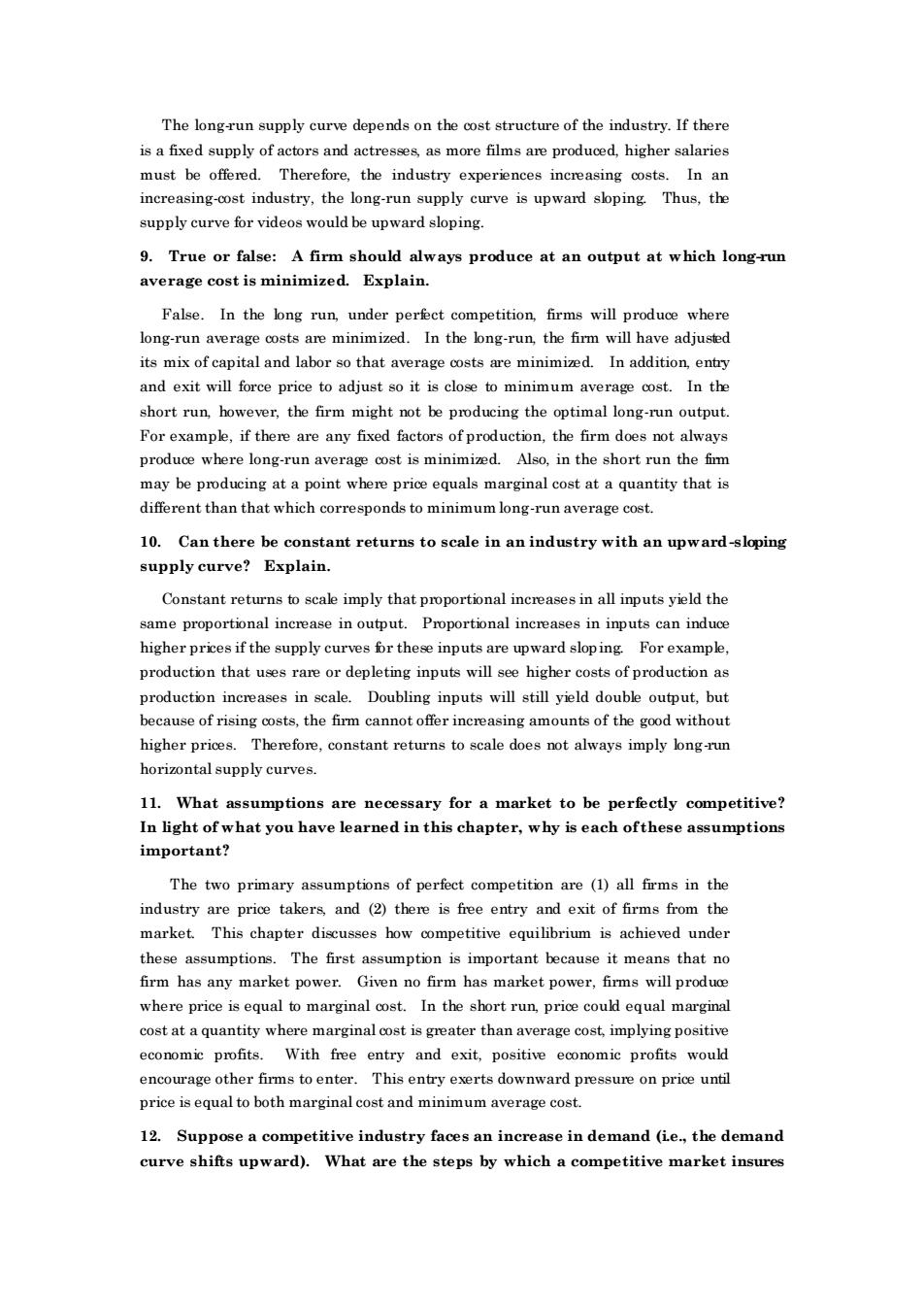正在加载图片...

The longrun supply curve depends on the cost structure of the industry.If there isa fixed supply of actors andactrea produed,higher must be offered. na increasing-cost industry,the long-run supply curve is upward sbping Thus,the supply curve for videos would be upward sloping. 9.True or false:A firm should always produce at an output at which long-run average cost is minimized.Explain. False.In the long run under perfect competition firms will produce where long-run aver its mix ofc mdIo the bng-ran the fimm edd ion,ent and exit will force price to adjust so it is close to minimum average cost.In the short run,however,the firm might not be producing the optimal long-run output. For example.if there are any fixed factors of production.the firm does not alwavs produce where long-run ave rage cost is minimized Also.in the short run the firm may be producing at point where marginal cost ata quantity that is different than that which corresponds to minimum long-run average cost. 10.Can there be constant returns to scale in an industry with an upward-sloping supply curve?Explain. Constant returns to scale imply that proportional increases in all inputs yield the same proportional increase in output.Pmoportional increases in inputs can induce higher prices if the supply curves or these inputs are upward sloping.For example. producton that depleting see higher production increases in scale.Doubling inputs will still yield double output,but because of rising costs,the firm cannot offer increasing amounts of the good without higher prices.Therefore,constant returns to scale does not always imply bng-run horizontal supply curves. 11.What assumptions are neo essary for a market to be perfectly competitive? In light of what you have learned in this chapter,why is each ofthese assumptions important? The two primary assumptions of perfect competition are (1)all firms in the industry are price takers and (2)there is free entry and exit of firms from the market.This chapter discusses how competitive equilibrium is achieved under these assumptions.The first assumption is important because it means that no firm has any market power.Give o firm ha market powor frms will produ where price is equal to marginal cost.In the short run price coud equal marginal cost at a quantity where marginal cost is greater than average cost,implying positive economic profits.With free entry and exit.positive economic profits would encourage other firms to enter.This entry exerts downward pressure on price until price is equal to both marginal cost and minimum average cost 12.Suppose a competitive industry faces an increase in demand (ie the demand curve shifts upward) What are the steps by which a competitive market insure The long-run supply curve depends on the cost structure of the industry. If there is a fixed supply of actors and actresses, as more films are produced, higher salaries must be offered. Therefore, the industry experiences increasing costs. In an increasing-cost industry, the long-run supply curve is upward sloping. Thus, the supply curve for videos would be upward sloping. 9. True or false: A firm should always produce at an output at which long-run average cost is minimized. Explain. False. In the long run, under perfect competition, firms will produce where long-run average costs are minimized. In the long-run, the firm will have adjusted its mix of capital and labor so that average costs are minimized. In addition, entry and exit will force price to adjust so it is close to minimum average cost. In the short run, however, the firm might not be producing the optimal long-run output. For example, if there are any fixed factors of production, the firm does not always produce where long-run average cost is minimized. Also, in the short run the firm may be producing at a point where price equals marginal cost at a quantity that is different than that which corresponds to minimum long-run average cost. 10. Can there be constant returns to scale in an industry with an upward-sloping supply curve? Explain. Constant returns to scale imply that proportional increases in all inputs yield the same proportional increase in output. Proportional increases in inputs can induce higher prices if the supply curves for these inputs are upward sloping. For example, production that uses rare or depleting inputs will see higher costs of production as production increases in scale. Doubling inputs will still yield double output, but because of rising costs, the firm cannot offer increasing amounts of the good without higher prices. Therefore, constant returns to scale does not always imply long-run horizontal supply curves. 11. What assumptions are necessary for a market to be perfectly competitive? In light of what you have learned in this chapter, why is each of these assumptions important? The two primary assumptions of perfect competition are (1) all firms in the industry are price takers, and (2) there is free entry and exit of firms from the market. This chapter discusses how competitive equilibrium is achieved under these assumptions. The first assumption is important because it means that no firm has any market power. Given no firm has market power, firms will produce where price is equal to marginal cost. In the short run, price could equal marginal cost at a quantity where marginal cost is greater than average cost, implying positive economic profits. With free entry and exit, positive economic profits would encourage other firms to enter. This entry exerts downward pressure on price until price is equal to both marginal cost and minimum average cost. 12. Suppose a competitive industry faces an increase in demand (i.e., the demand curve shifts upward). What are the steps by which a competitive market insures